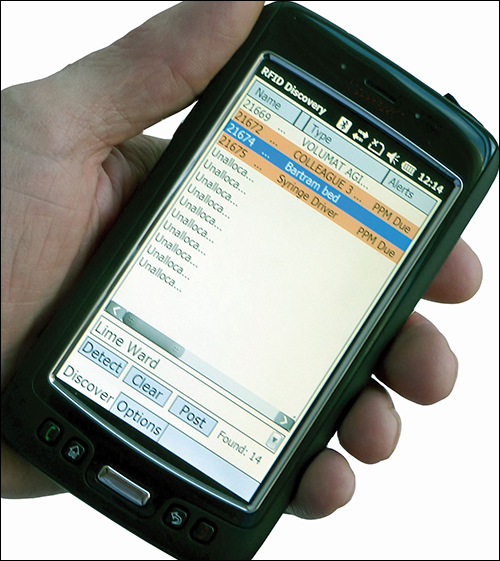Jul 15, 2015The Heart of England NHS Trust's estates department (responsible for managing the trust's hospital buildings, infrastructure and equipment) is piloting radio frequency identification technology at Good Hope Hospital to locate and manage its beds. The RFID system will track both standard and specialized beds, as well as hoists used to lift patients onto and off of them. Once fully deployed, the solution will track approximately 2,000 beds and hoists across the three hospitals, based on the pilot's results.
About a year ago, the trust's clinical engineering department—which manages mobile medical devices, such as infusion pumps and monitors—deployed an active RFID system provided by Harland Simon. It has attached active 2.4 GHz tags, which use a proprietary air-interface protocol, to each of about 2,000 medical devices, and is currently tracking their locations and movements among different sites within the three hospitals that make up the trust.

David Smith, the estates manager at the Heart of England NHS Trust, says that based on the system's effectiveness at monitoring medical devices, the estates department is now piloting the same technology for its beds and hoists. Smith's goal is to reduce the amount of time that the department's engineers spend searching for beds to conduct maintenance and inspections, and to ensure that beds do not become overlooked and thus miss those inspections. In the latter case, the concern is that a bed could be unsafe for use if not properly inspected. Inspections are scheduled twice annually for each bed.
"If you can't find the beds, they might not be maintained," Smith explains, "and that could be a safety issue."
The solution, known as RFID Discovery, consists of proprietary readers deployed throughout the hospitals, as well as Discovery software residing on the departments' own servers. Andy James, Harland Simon's sales manager for RFID Discovery, says that for the Good Hope deployment, the RFID Discovery software is integrated with the hospital's Qube Global facilities-management software. In that way, staff members can look up a specific bed or hoist in the management software, along with its maintenance history, and view its location based on RFID Discovery read data.
Harland Simon RFID tags, manufactured for Harland Simon by a third-party manufacturer, are set to transmit a unique identifier every 20 seconds. At that transmission rate, a tag's coin cell battery typically lasts for about 20 months.
When applying a tag to a bed or hoist, hospital personnel first use a PDA with a built-in bar-code scanner to read a bar-coded serial number printed on a label attached to the bed or hoist itself, and then the bar-coded serial number on the front of the RFID tag, which is the same number as the one transmitted by the tag. The tag and bed (or hoist) ID numbers are thereby stored in the Discovery software and forwarded to the facilities-management system. Employees can input the maintenance date for a particular item so that users can be alerted in advance when that object is again due for maintenance or servicing.
The three facilities currently have a total of 50 Harland Simon readers installed, 17 of which are being used at Good Hope. (The devices are also custom-made by a third party for Harland Simon.) These readers include those in use for the clinical engineering department's mobile-device tracking system, as well as others added to provide further granularity of bed location. The trust plans to install additional readers as needed.
Typically, readers capture a tag's ID at a distance up to 20 meters (65.6 feet). As the Discovery software receives data from the readers, it can approximate the location of that bed or hoist and then display that location on a dashboard that includes a map of the facility and an icon representing each tagged hoist or bed. In this way, the hospital staff can utilize the solution to identify where beds and hoists are located when engineers conduct inspections and any necessary maintenance. The software can also be used to determine when there are too many accumulating in one area, or not enough in another.
Additionally, the PDA comes with a Bluetooth-enabled handheld reader that the estates department staff can carry around the hospital to locate specific items or collect inventory data. Users can simply select the location at which they seek to read tags from a drop-down menu, and the Discovery software will display the items whose tags are being interrogated, as well as indicate whether the signal strength is high (meaning the device is within 5 meters of the reader), moderate or low (meaning it is more than 10 meters from the device).
The hospital is still in the process of tagging beds, Smith says, and not all readers are yet in place, so the solution is being tested initially with handhelds on tagged beds or hoists. To date, he reports, the system is providing the data he was hoping to attain. In September 2015, Smith expects the pilot to be completed, at which time his department plans to assess the results and make plans for a rollout to all three hospitals. That rollout would be expected to occur in 2016. In addition, Smith says, he is investigating the system's use in tracking other things, such as keys used to unlock doors and cabinets, as well as wheelchairs and stretchers.

